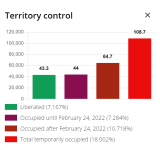Ukraine : pour abattre en masse les Su-34 et Su-35 russes, Kiev pourrait avoir piraté leurs avionique et systèmes embarqués
Ukraine: in order to shoot down Russian Su-34s and Su-35s en masse, Kiev may have hacked into their avionics and on-board systems
According to analyst Tom Cooper, the recent mass slaughter of Russian Su-34 and Su-35 fighters and bombers could be due to Ukraine "hacking" their onboard electronic systems, rendering them blind to any threat.
Eleven? Twelve? Thirteen? Fourteen in ten days, according to a recent article published by Newsweek, based on figures provided by the Ukrainian armed forces: in recent days it has become hard to keep track of the number of Russian aircraft, particularly the precious Su-34 and Su-35, that have been shot down by Kiev's anti-aircraft defences.
If we add to these fighters and bombers two rare Beriev A-50 detection and command aircraft, which were shot down within a few weeks of each other, the terms "hecatomb" or even "massacre" do not seem to be misused.
How can we explain the hecatomb of the Russian air force?
While Vladimir Putin's Russia is trying to extend its advantage on the ground after its deadly victory at Avdiivka, it is suffering terribly in the air, facing a Ukraine that has not yet received the reinforcements of its long-awaited F-16s. How can we explain such a bad patch?
Firstly, through increased activity near the front. As we explained a few days ago, appearances can be deceptive. The Russian break-up is partly due to a marked increase in sorties close to the front lines, with Russian aircraft once again approaching to provide direct support to ground assaults, as Forbes reiterates.
After staying well behind their lines for a long time, making extensive use of glide bombs to spread hell in the Ukrainian ranks, the Su-34s and Su-35s have ventured more often into range of the Ukrainian Patriot or NASAMS anti-aircraft batteries, which have had a greater chance of spotting and shooting them down. Statistically, the drastic increase in Russian air force losses seems logical.
But that may not be all. An Austrian analyst, Tom Cooper, offers another lead, detailed by the Kyiv Post and, it should be noted, which remains only a hypothesis at this stage: the avionics of the Su-34 and Su-35, i.e. their on-board electronic detection and countermeasure systems, could have been "compromised" by Ukraine.
Compromised avionics, with American help?
Tom Cooper notes that very early in the war, Ukraine was able to get its hands on the carcasses of Su-34s and Su-35s that had been shot down by its defences. Some of them fell to the ground in better condition than others, and perhaps their electronic systems were found intact by Kiev's intelligence services.
Including a radar section capable of detecting targets as well as threats, or jammers activated to deceive enemy systems, both radars and missiles, this cutting-edge avionics system would then have been dissected by the Ukraine, possibly with technical assistance from the United States, delighted to discover such secrets.
Tom Cooper mentions the National Air and Space Intelligence Center, which could have helped Kiev to dissect this precious Russian avionics, and consequently to find the settings and tweaks that would have enabled the Ukrainian radar and missile systems to detect and mow down their Russian targets without being detected.
As the Kyiv Post explains, pilots call this "flying fat, stupid and happy", believing in safe skies when the deadly threat is already fixed on their aircraft.
This blindness to Ukrainian detection and missiles is all the greater given that Kiev has shot down two Beriev A-50s, the rest of the Russian fleet having been grounded according to British intelligence, reported by Newsweek.
The role of these detection and command aircraft, as sharp-eyed conductors of the skies, is precisely to support the Kremlin's fighters and bombers, to detect possible threats or even missile launches, and to help the Su-34 or Su-35 get out of trouble.
The destruction of these two A-50s, as well as an Il-22 with a similar role in January, could therefore continue to weigh heavily on the survival capabilities of the Russian air force engaged in Ukraine.



